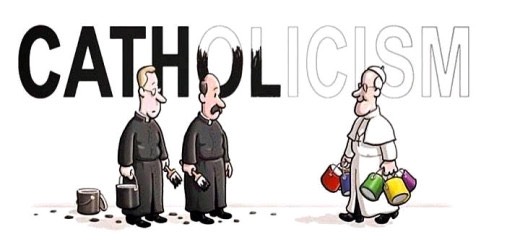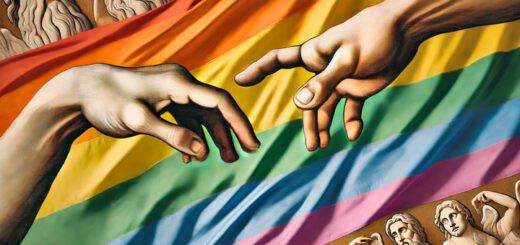Misogyny towards women and homophobia in the Catholic Church
 Reflections of the theologian John J. McNeill*, freely translated from Bruno
Reflections of the theologian John J. McNeill*, freely translated from Bruno
There has been and continues to be a profound connection between misogyny and homophobia in our culture. Misoginia is defined as fear and hatred towards the woman.
It manifests itself psychologically in the repression of everything that, in the psyche, is traditionally connected with the female (for this reason I would prefer to use the term femaleophobia).
Among other things, this includes all emotions, feelings of compassion, all spiritual feelings, all dependencies and all needs of the community.
More than sixty years ago G. Ratrey Taylor in his classic book Sex in history [Sex in History, New York, 1954; tr. it. Longanesi, 1957] tried to tell some of the cultural conditioning concerning sexuality.
He found a constant in cultures based on a patriarchal principle. These cultures with few exceptions tend to combine a highly subordinate vision of the woman with repression and horror towards male homosexual practices.
The institution that, in today's culture, continues to preserve the clearest expression of that form of patriarchy, including its homophobia, is the Roman Catholic Church.
On the contrary, cultures based on a matriarchal principle are prone to combine an improvement in women's status with a relative tolerance for male homosexual practices.
Taylor concludes that the tradition of the Christian West is basically based on patriarchal culture. This can help to explain some surprising anomalies from an ethical point of view in this tradition.
One of the most remarkable anomalies is the almost complete indifference towards lesbism in the Western Christian tradition.
For example, the code of holiness in the Old Testament [editor's note: the set of rules addressed to Israel so that "holy" was maintained; These rules occupy the chapters from 17 to 26 of the Levitic book] explicitly condemns the homosexual practices by males and the bestiality by women under penalty of death, but not mentioning lesbian practices are not made. This must not surprise whether you remember the fame of King Davide to have an harem of almost a thousand women.
In addition to a reference, whose interpretation is not entirely shared, to unnatural female acts made by Paolo in Roma 1:26 there is no other reference to lesbian activities in writing and almost nobody in all the other documents of the Christian tradition.
There is a marked tendency in all the sources of the Christian tradition to condemn sodomy as an act of a man who "assumes the role of women" in the relationship with another man. This has led to the cultural tradition to respect the man who plays the active role in penetration and despise the man who plays the passive role.
This tradition is still strong in particular in the culture of Latin countries of origin. As Bailey observed, this was considered in tradition not so much as a violation of human nature, but rather as a degradation of the male as such.
If there is a certain message in the biblical history of Sodoma and Gomorra, it is the belief of absolute respect that at the time had to be addressed to the males and the relative lack of concern for the female.
A perfect example of this are Lot's words to the crowd who threatens to attack his male guests: “Please, my friends do not be so depraved. I have two daughters who have never had relationships with a man, let them take them out and do them what you like; Only do not do anything to these men, because they came to the shelter of my roof "(Gen 19: 7-8).
All Jewish males at the time of the Old Testament prayed as follows: "Thanks to God I was not created a woman!"
Stimulating or encouraging or forcing another man to simulate passive coatal function represented an intolerable perversion for a society organized according to the theory of women's essential subordination to men, a society that particularly appreciated male aggression and dominion.
My impression is that this attitude is still strongly present in some sectors of Muslim society.
Consequently, as Bailey observes, a man who "acted as a woman in a sexual act" was treated as one who betrayed not only himself, but all his sex, dragging his companions with him in his voluntary misfortune.
Bailey concludes with this declaration: “It could perhaps be frankly for us to look in the face of the fact that the rationalization of sexual prejudices, animated by false notions of sexual privileges, has played a not negligible role in the formation of the tradition that we have inherited and probably still Today it checks the opinions and policy on homosexuality, to a greater extent than you commonly think. "
More recently, the historical connection between misogyny and homosexuality has been significantly illuminated by Richard Tarnas in his brilliant study of the evolution of western culture: Passion of the Western Mind. Undersanding The Ideas That Have Shaped Our World View (New York: Ballantine Books, 1991).
The basic intuition of Tarnas is that the last three thousand years of development of philosophy, science, religion and culture have been an exclusively male phenomenon, from the beginning to the end.
It is my belief that the dialectical historical process that led to the development of the male archetype, with the repression of the female it represents the movement of what psychologists call Anima-Animus Mundi.
His thesis in the past was the development of the male archetype which, for some mysterious reason, had to be made first; Its antithesis in the present and in the future will be the elaboration of a female archetype, which will not contradict or repress the male, but in the end it will result in the synthesis of a androgine completeness of all human beings, males and females.
I suspect that the historical process aimed at elaborating the male archetype first, creating the separate and independent human individual, had to do with the greater power and closeness to the life and nature of the female.
If the female archetype had been first developed, male development, which is much more fragile, could never have occurred or would have occurred only with extreme difficulty. At this point of the comparison, we can no longer simply return to the maternal matrix, as an adult could not find his fullness in the mother's womb.
The "man" of the western tradition was an investigator hero, a biological and metaphysical promote, who constantly sought freedom and progress for himself, and who has therefore always fought to differentiate and acquire control of the matrix from which It had arisen.
This Prometheic hero is present both in men and women.
The evolution of western thought was guided by a heroic impulse to give life to an autonomous, conscious, rational self, separating itself from the primordial unity with nature.
The result of this process was the transcendent self, the independent individual ego, the self-determination of the human being in its existential uniqueness, separateness and freedom.
The moment of female balance has to do with the construction of a spiritual community of love and a profound relationship passionate about personal love with the other and the divine, a relationship built not on an immersion of our ego and identity In a generic community or matrix, but is instead built on a relationship and a community freely consisting of free, autonomous, independent and self-determined individuals.
Why, Tarnas wonders, the pervasive masculinity of the western, intellectual and spiritual tradition has become so evident for us over the last forty years, when it had remained invisible and unaware in almost all previous generations?
Only through the feminist movement in the last forty years have we become aware of how exclusively male are, for example, our usual liturgy prayers. Hegel once observed: "The Civetta di Minerva expands the wings only to the fall of the twilight."
Each civilization is unaware of itself, until it reaches its decline; It is only then that it becomes fully aware of what pervades it. True wisdom and knowledge can only be achieved in the final point. The male tradition of three thousand years of western civilization is reaching its apogee and was led to become aware of the extreme unilaterality of its late modern attitude.
The evolution of western thought was based on the repression of the female, "on the repression of the unitary unitary consciousness, of the mystical participation in nature, of the progressive denial of the Mundi soul, of the community of being, of the mystery and ambiguity, of 'imagination, emotion, instinct and sexuality of the body, nature and women ". (Tarnas: p. 442).
Today men and women face the existential crisis of being lonely and conscious ego of their death, thrown into a senseless universe and ultimately unknowable, an environment that is increasingly artificial, mechanistic, fragmented, without a soul, and cars -destructive. The evolution of the male archetype has reached a dead end.
If you continue in this unilateral dialectic, the human race will be faced with the real possibility of self-destruction through nuclear war or a widespread environmental collapse. Human beings feel progressively isolated, alienated by their communities, by nature, and from each other.
Tarnas believes that the solution of this crisis is already underway in the birth of the great female archetype in our culture. He warns this phenomenon as visible in the birth of feminism, the growing emancipation of women, and the widespread opening towards female values expressed by both men and women. Find further proof of this in the widespread desire to reconcile with the body, emotions, unconscious, imagination and intuition.
"The most deep -rooted passion of western mentality was to meet with the depths of one's being. The impulse that guided the consciousness of the West was dialectical research, not only to achieve oneself and to forge one's autonomy, but also to recover one's connection with everything, coming to terms with the great female principle in life: differentiating but alfine get to rediscover and reunite with the mystery, with the mystery of the female life, of nature, of the soul.
And this reunification can now take place on a new level and deeply different from that of the unconscious primordial unity, because the long evolution of human consciousness has able to finally embrace the land and the matrix of its being, in a free and aware way.
Telos, the inner sense and goal of western mentality was to restore contact with the cosmos in a mystical and mature participation, to deliver freely and consciously in the arms of a wider unit, which preserves the autonomy of man, while transcending human alienation. " (Tarnas: pp 443-444).
Tarnas concludes his remarkable work with the affirmation that the incessant inner development and the persistent male system of reality that characterizes the western mentality have been gradually led towards reconciliation with the lost female unity, towards a deep marriage and many levels of the male and female, a triumphant and restorative meeting. “Our time is struggling to bring to light something new in human history.
We seem to be witnessed, in the suffering, of the labor from which a new reality will be born, a new form of human existence, a "child" who would be the result of this archetypal marriage and which would bring all its antecedents in a new form ".
“This wonderful western project should be seen as a part, necessary and noble, of a large dialectic and not simply rejected as an imperialist-school conspiracy.
Not only this tradition has produced the fundamental differentiations and the autonomy of the human person, which alone can allow the possibility of such a greater synthesis, but also has meticulously prepared the way for its self-foundation.
In addition, this tradition has resources, left behind and discarded by its Prometheic development, which we have just started to integrate and which, paradoxically, only the female opening will allow us to fully integrate.
Every point of view, male and female, is here simultaneously stated and transcended, recognized as part of a bigger one; In fact, each polarity needs the other for its own fulfillment.
And their synthesis leads to something beyond itself: it brings an unexpected opening to a larger reality that cannot be grasped before it arrives, because this new reality is in itself a creative act. “(Tarnas: p.445).
The role of the LBGT community in the great dialectic
Although with my great amazement Tarnas makes no mention of it, in parallel with the birth of the liberation of the woman, a gay positive identity has emerged during the last fifty years at all levels - social, political, cultural and spiritual - all over the world.
Jacque Perotti, the founder of the European European language Catholic group "David et Jonathan", speaks of this same era as a "declic" "a shot, a special moment in history, a revelation of the slow emergence of a positive homosexual identity from the heart of the world. After so many centuries of rejection, destruction and intimidation, a wind of freedom has started to blow". In our day that wind has become a hurricane.
This emergence of a positive gay identity has undergone acceleration in recent years to a significant extent, and I believe it has a teleological purpose in the development of the soul-Animus Mundi.
This presence of a gay and lesbian visible world community, for the first time in the last three thousand years, is an integral part of this dialectic, and it is another aspect of the recovery of the female or, as I prefer to call it, of the balance of the male and female in a new synthesis in the human personality
Clearly the dominant dialectic of the male archetype in the past, together with the repression of the female, has also included the repression of homosexuals.
As G. Rattrey Taylor pointed, patriarchal cultures combine a view of women as subordinated with a strong repression of homosexual practices between males. The rise of the feminist liberation movement in recent years gives a reason for hope that GLBT people will be fully accepted in the human community that will come.
Al centro di ogni omofobia c’è la misoginia e la repressione del femminile. I gay sono visti come una minaccia al patriarcato, perché sono spesso in contatto e in accordo con la dimensione femminile di se stessi.
È chiaro che la liberazione femminile e quella gay sono così intimamente legate che i gay dovrebbero offrire un pieno sostegno per la liberazione delle donne e viceversa.
Nessun processo dialettico può riuscire, a meno che non porti in sé il seme della sintesi. Questi semi di sintesi si trovano nella comunità gay.
La sintesi può avere successo soltanto attraverso l’emergere di un gruppo visibile in grado di vivere pienamente le proprie dimensioni, sia maschile che femminile, senza la necessità di reprimere l’una o l’altra.
Abbiamo bisogno di un gruppo che possa fungere da modello per la meta ideale dell’attuale evoluzione dell’umanità, persone che sanno mantenere la propria dimensione maschile e femminile in buon equilibrio e portare avanti una sintesi equilibrata delle due.
Questo, credo, è il ruolo provvidenziale dei gruppi politici e spirituali GLBT, che sono nati nel corso degli ultimi cinquant’anni.
Noi che siamo gay e lesbiche abbiamo bisogno di una visione e dobbiamo essere chiari su quali sono i doni che portiamo a questo momento della storia e il ruolo centrale che dobbiamo svolgere nel far emergere la pienezza di vita per tutti gli esseri umani.
This role is played in particular in the gay context of a new paradigm for human marriage, which replaces the now destructive patriarchal paradigm.
In gay marriage, both parties relate to each other as equal to each other. Neither sides is under pressure to repress an entire dimension of all his humanity: the female for men, the male for women.
Both sides can relate to each other as complete human beings. Seen in this light gay marriage is a gift from God who can save all marriages from their current trend to failure.
* Father John McNeill He is a pioneer of the Gay Liberation Movement, he contributed to the Foundation of Dignity New York City, a spiritual support group for gay and lesbian Catholics, in 1972.
In 1976 he published "The Church and homosexuality", the first great theological criticism of the traditional ecclesiastical condemnation of lesbian and gay relationships. In 2007 he was awarded the National Gay and Lesbian TaskForce Lifetime Achievement Award (the prize for the creation of a lasting national TaskForce of gays and lesbians) "thanks to the fact of having opened the way in making it clear that being gay is a gift from God".
John J. McNeill has published "Freedom, glorious freedom in Italy. A journey of spirituality and liberation for believing homosexuals" (Ega-Edisi Group Abele, 1996) and "Betting on God. Theology of homosexual liberation" (Ed. Sonda, 1994).
Original text
> To learn more: Homophobia.org - chronicles of ordinary homophobia
Statistics, data, graphs, information, reflections, and report on homophobia in Italy
On Homophobia.org You discover:
- How homophobia grows in Italy
- In which regions there are most victims
- If homophobia causes more suicidal or more murders
- If it affects more men, women or transsexuals
- How many victims have been this year or in recent years
- What is homophobia
- What is internalized homophobia
- The list of episodes of homophobia
- Our reports on homophobia
- Testimonies, experience and articles on homophobia






